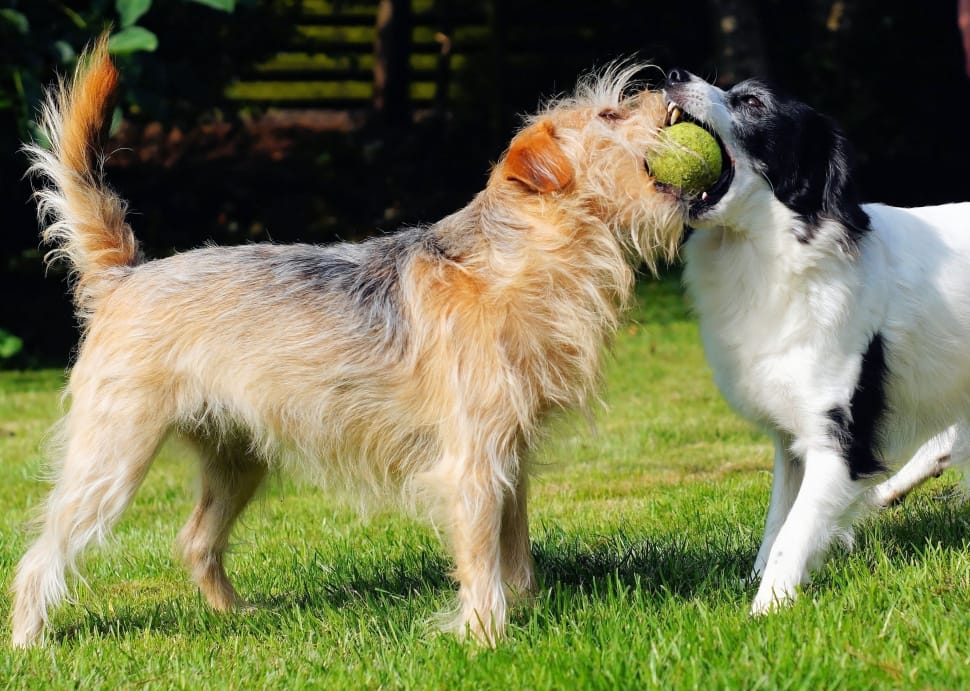Breeding dogs is a fascinating subject that has garnered attention from animal lovers and breeders alike.
It involves the reproductive process of dogs and the genetics that come into play when producing a litter of puppies.
From choosing the right pair of dogs to understanding the intricacies of their reproductive systems, there is a lot that goes into dog breeding.
In this article, we will dive deeper into the world of dog breeding and shed light on the different factors that come into play during the process.
How Does Breeding Dogs Work
Canine Reproduction Basics

As a dog lover, it is essential to understand your furry friend’s reproductive health and behavior to ensure their well-being. In this article, we will take a closer look at the basics of canine reproduction.
Understanding Canine Reproductive Anatomy
- Male Reproductive System – The male dog’s reproductive system consists of the testicles, the scrotum, the penis, and the prostate gland. The testicles produce sperm, and the penis is the organ used for mating. The prostate gland adds fluid to the semen, which helps nourish and protect the sperm.
- Female Reproductive System – The female dog’s reproductive system includes the ovaries, the uterus, the cervix, the vulva, and the vagina. The ovaries produce eggs, which are released during the estrus cycle (heat). The uterus is where fertilization and fetal development occur.
The Canine Estrus Cycle
- Phases of the Cycle – The estrus cycle is the reproductive cycle of female dogs, and it consists of four phases – proestrus, estrus, diestrus, and anestrus. Proestrus is the initial stage of the cycle, and the female will produce a bloody discharge. Estrus is the stage where the female is receptive to mating and can be identified as being “in heat.” Diestrus is the luteal phase that determines whether or not the female is pregnant, and anestrus is the resting phase between cycles.
- Signs a Female Is in Heat – During estrus, the female dog may display signs such as increased urination, restlessness, and an attraction to male dogs. Physical signs may also include a swollen vulva and a bloody discharge.
Fertilization and Gestation
- Process of Fertilization – Fertilization occurs when sperm meets an egg in the female’s reproductive tract. The fertilized egg travels to the uterus, where it attaches to the uterine wall and begins to develop into a fetus.
- Length of Canine Gestation – The gestation period for dogs is usually around 63 days. It is essential to monitor the pregnant dog’s health during gestation regularly.
- Pregnancy Detection Methods – Pregnancy can be detected through a variety of methods, including ultrasound and hormone testing. Your veterinarian can help you choose the best method for your dog.
Understanding the basics of canine reproduction is crucial for every dog owner. By being aware of your dog’s reproductive health and behavior, you can help ensure they lead happy and healthy lives.
See also: How To Care For a Newborn Litter of Puppies [Complete Guide]
How Does Breeding Dogs Work

Dog breeding is a complex process that requires careful consideration and planning.
There are various reasons why dogs are bred, including for the preservation of breed traits, improving health and temperament, or performance and working abilities. Here we will discuss the basics of how dog breeding works.
- Determining breeding goals – Before breeding dogs, it is important to establish clear goals. It could be improving the breed standard or preserving specific traits or enhancing working abilities. Whatever it might be, it is crucial to determine the goals of breeding.
- Preservation of breed traits – Breeders aim to preserve specific physical and behavioral traits that define a particular breed.
- Improving health and temperament – Breeders must prioritize the health and temperament of the dogs they breed to avoid any serious health issues or behavioral problems.
- The performance or working abilities – Breeders may opt for breeding dogs to enhance the working or performance abilities of their offspring.
- Selecting breeding dogs – The right breeding dogs should be selected based on their physical and behavioral attributes, bloodlines, and their overall capacity to breed.
- Assessing health, temperament, and conformation – Breeders must assess the potential parents’ overall health, temperament, and body structure to produce healthy offspring.
- Genetic compatibility – Ensuring genetic compatibility between the breeding pair is important to avoid breed-specific health issues such as hip dysplasia in German Shepherds.
- Pedigree analysis – Breeders can analyze the pedigree of potential parents to look for common ancestors that pass on desired genes.
- Linebreeding, inbreeding, and outcrossing – Breeders have options like linebreeding, inbreeding, and outcrossing, depending on their breeding goals.
- Advantages and disadvantages of each method – Each breeding method comes with its own set of advantages and disadvantages.
- Balancing genetic diversity and preserving breed traits – Balancing genetic diversity and preserving breed traits are two crucial aspects of dog breeding.
How Does Breeding Dogs Work
See also: How To Choose The Best Feeding Schedule For Your Puppy
Mating Methods and Techniques
Dog breeding involves several mating methods and techniques, each with its unique advantages and disadvantages. In this article, we will take a closer look at the different methods and techniques used to breed dogs.
Natural Mating
Natural mating is the traditional method of mating where two dogs are allowed to breed naturally without human interference.
This method is known to be the least expensive and less risky than other methods. However, it is not always viable because the mating process could be interrupted or unproductive, or the dogs may not be compatible.
Artificial Insemination
Artificial insemination is a process of manually introducing semen into the female dog’s reproductive system. This method is ideal for breeding dogs that are geographically distant or have difficulty breeding naturally. It also allows breeders to store and transport semen for future use.
This method is more popular because breeders can have better control over the breeding process. The downside is this method is more expensive and requires specialized equipment.
Surgical Insemination
Surgical insemination is a process where the semen is directly introduced into the female dog’s ovaries using a surgical procedure. This method is an option when natural and artificial insemination fails to produce puppies.
The surgical insemination method is expensive, and riskier for both the dog and the veterinarian performing the procedure.
Embryo Transfer
Embryo transfer is a technique where the fertilized eggs, or embryos, are harvested from a female dog and placed into another female dog’s uterus where they will develop until delivery.
This method is useful when a female dog has had problems carrying a pregnancy to term or another female dog better fits mating characteristics. Embryo transfer is a costly process that requires specialized equipment and expertise, and the success rate is not always high.
In Vitro Fertilization
In vitro fertilization (IVF) is a process of fertilization performed outside of the female dog’s body, where eggs are harvested and fertilized with sperm in a lab. After fertilization, the embryos are transferred into the female dog’s uterus to develop until delivery.
This method is useful when natural and artificial insemination methods fail, or the male dog is deceased. In-vitro fertilization is a complex and costly procedure, and the success rate is not always high.
How Does Breeding Dogs Work
Canine Pregnancy From Start To Finish
Understanding canine pregnancy is crucial when it comes to breeding dogs or caring for a pregnant dog. The following are steps in canine pregnancy from start to finish:
Step 1: Mating
Mating is the first step in canine pregnancy, where the female dog is receptive and releases mature eggs for fertilization.
The mating process should be done when the female dog is in heat, showing signs like swollen vulva, increased urination, restlessness, and attraction to male dogs.
Step 2: Fertilization
Once the male’s sperm and the female dog’s eggs meet, fertilization occurs. The fertilized eggs develop into an embryo, which settles in the uterus and starts to divide.
Step 3: Implantation
Implantation occurs within four to six days after fertilization where the embryo attaches to the uterus’s inner lining. The embedding process keeps the embryo in place to allow for continued growth and development.
Step 4: Week 1-3
During this stage, the embryo develops vital organs such as the heart, kidneys, and liver. It is the most delicate stage, and it is essential to take special care of the pregnant dog.
Step 5: Week 4-5
The puppy’s skeletal system starts developing, and its eyes, ears, and limbs are beginning to form. The fetal heartbeat can be palpated by a professional veterinarian.
Step 6: Week 7-8
During this stage, the puppies’ faces are more pronounced, and the skin pigment starts to emerge. The puppies also start to move, indicating a healthy pregnancy.
Step 7: Week 9-10
This is the final stage of pregnancy, and the puppies start to move into position for delivery. The pregnant dog’s belly becomes enlarged, and she might become restless, and anxious, and display nesting behavior.
A veterinarian might conduct an X-ray scan to detect the number of puppies and evaluate their development.
Step 8: Labor and Delivery
Labor and delivery is the final stage of canine pregnancy, and it could occur between day 59 and day 67 after fertilization. The pregnant dog might indicate labor by showing signs such as panting, pacing, shivering, and loss of appetite.
The set-up for delivery should be prepared in advance, and a veterinarian should be consulted in an emergency during delivery. After delivery, proper care of the newborn puppies and the mother is crucial.
How Does Breeding Dogs Work
In Conclusion
In conclusion, breeding dogs is not a simple process but one that requires careful consideration of multiple factors.
Breeding dogs requires knowledge of genetics, health testing, and proper care during and after pregnancy.
It is important to ensure that the breeding of dogs is done ethically, with the aim to improve the breed while also ensuring the health and welfare of the dogs involved.
With the right information and resources, however, dog breeding can be a rewarding and fulfilling experience for breeders and animal lovers alike.





Leave a Reply